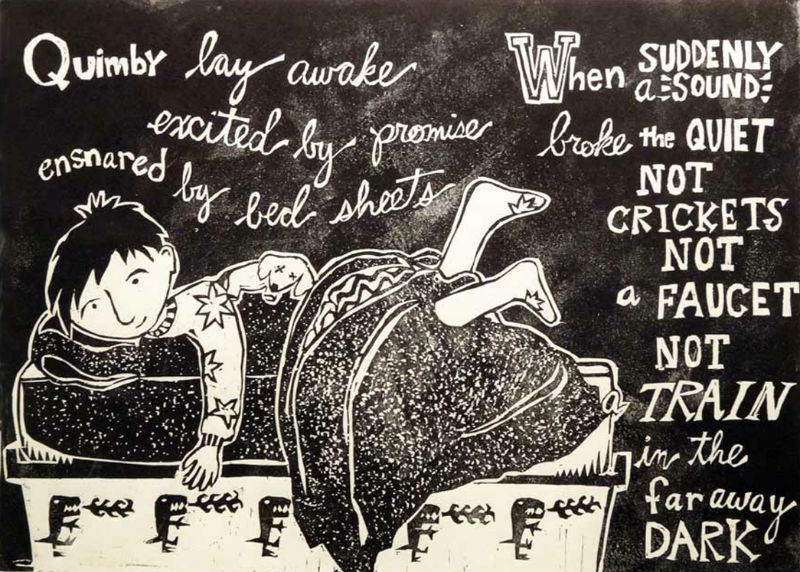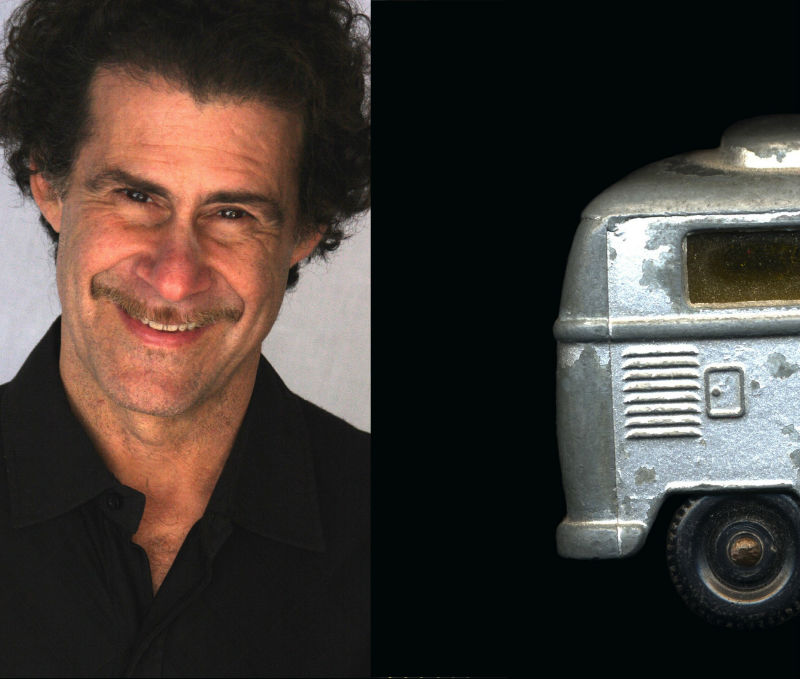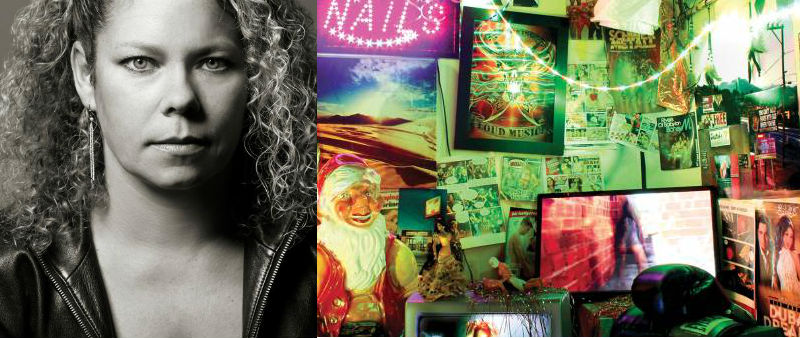Carving Out a Niche: Marian Short's "Cakeasaurus: Scenes From a Picture Book"

Cakeasaurus, the gleefully cake-thieving, sweet-sneaking monster brainchild of Ann Arbor printmaker/storyteller Marian Short, will be lurking on the walls and in the halls of the Taubman Health Center's North Lobby from now until June 11, 2017. Cakeasaurus: Scenes From a Picture Book is curated by Gifts of Art, a program designed to bring art and music to patients, visitors and staff in the University of Michigan Health System.
Amusingly paired with this series of Cakeasaurus prints are the sweet yet dangerous-looking glass confections of Janet Kelman. A combination of pate de verre, slumped and sheet glass, the sugary looking cupcakes and gateaux look delicious, but engender feelings of both attraction and dismay at the thought of biting into one of these glossy but inedible desserts. Cakeasaurus beware!
The (mostly) wood block prints in Cakeasaurus: Scenes From a Picture Book describe the exploits of the cake-stealing monster through its 8-year development from inception into what Short hopes will soon become a children’s book. They track the artist’s process as she refines, rethinks, and develops the story visually and narratively. Short is generous and humorous in her explanations of her creative process and thoughtfully provides several large explanatory prints, visually satisfying in their own right, to accompany the smaller artworks.
Purple Rose’s Vino Veritas finds humor and pain in the middle class

The Purple Rose Theatre has made its mark as an outstanding professional theater company with smart, contemporary comedies with a sting.
So it’s appropriate that the Chelsea theater founded by Jeff Daniels would mark its 100th presentation with a new production of Detroit playwright David MacGregor’s Vino Veritas, which had its world premiere at the Purple Rose in 2008. It is a fine example of the plays that the company has premiered over the years. It’s contemporary, witty, fast-paced but also biting, brutally honest, and perceptive about the worries and frustrations of middle-class Americans.
Vino Veritas is set in “an upper middle class living room” on Halloween night. As the play opens a couple are waiting for their neighbors to come for a drink before they all head off for their annual appearance at a costume party.
The couple has recently returned from a trip to Peru. This was a rare adventure for the two studio photographers who had once been daring photojournalists. It was, it seems, an attempt to re-spark a troubled relationship. While there, the wife is given a bottle of wine made from the skin of blue dart tree frogs. The wine is alleged to be a truth serum.
The wife wants to share the wine with their neighbors; the husband is horrified by the idea. The madness ensues when the wine flows.
Complicite’s "The Encounter" is a hallucinatory audio playground

Thursday’s opening night performance of Complicite’s The Encounter, presented by UMS (and running through Saturday night), got me thinking about how, when you’re a parent of young kids, you notice on a daily basis how their powers of imagination, and capacity for wonder, utterly dwarf your own. Now, this isn’t too surprising when you consider how often kids are encouraged to conjure up stories and images, while the adults around them are stuck in “adulting” mode: worrying about work, home upkeep, money, relationships, emails, appointments, and various other responsibilities.
So how do you lure a capacity crowd of over-stressed adults down the rabbit hole of imagination and deep into the Amazonian rainforest? By finding new, innovative ways to open this often-jammed door in our brains.
With The Encounter, Complicite -- one of Britain’s (and the world’s) most inventive theater companies -- achieves new levels of theatrical immersion by delivering the show’s time-hopping, atmospheric narrative to the audience through headphones; employing a visceral, binaural soundscape (designed by Gareth Fry, with Pete Malkin) that does a real number on your perception; and through employing lighting (Paul Anderson) and projections (Will Duke) that make a deceptively spare set (Michael Levine) -- with a textured foam backdrop, suggesting an enormous recording studio -- into a hallucinatory playground.
U-M’s "Insurrection" uses drama, comedy in a swirling, challenging trip through time

Time travel is a hot topic with three new television series featuring characters who travel back to historic events and learn some lessons about history and themselves.
Robert O’Hara’s 1995 play Insurrection: Holding History takes a fantastical and theatrical approach to time travel to offer some rich insights into African-American history and the continuing friction between black and white Americans.
The production by the University of Michigan’s Department of Theatre and Drama at the Arthur Miller Theatre takes a fine measure of O’Hara’s swirling combination of broad satirical comedy, cultural touchstones, and searing drama as Insurrection moves back and forth from the present to the doomed and bloody 1831 slave uprising of Nat Turner.
Theatre Nova's "Clutter" explores the traps of false memories

Much like a plaster casting mold, most modern American plays squeeze themselves into ready-made stylistic and thematic models that have a good track record. The styles can often be pinpointed back to one or two particularly significant behemoths that are scattered throughout the history of the American theater. One such theatrical prototype is the Memory Play. It was initially popularized by playwright Tennessee Williams in the preface for his 1945 drama The Glass Menagerie. As Williams described it, “When a play employs unconventional techniques, it is not, or certainly shouldn’t be, trying to escape its responsibility of dealing with reality, or interpreting experience, but is actually or should be attempting to find a closer approach, a more penetrating and vivid expression of things as they are.” The playwrights Pinter (Betrayal), Friel (Dancing at Lughnasa), and Leonard Jr. (The Diviners) are all known for their Memory Plays. Each examined different subjects, but all used the power of characters retelling their memories and dreams to exaggerate details in order to increase the emotional impact of those stories. Clutter, the new show at Theatre Nova written by Brian Cox, is a world premiere Memory Play about the traps of false memories that we set for ourselves by taking part in nostalgic rumination.
All the Way In: Diving into the Ann Arbor Film Festival for the first time
hashtag by Sherlonya Turner
Confession: Despite living in the greater Ann Arbor area for nearly 20 years, I have never attended any part of the Ann Arbor Film Festival.
The poster caught my attention. I’m a sucker for bright colors.
Seduced by the orange, pink, and yellow in this year's AAFF poster, I thought, "Wouldn’t it be funny if I watched as many episodes of Dallas as I can before the film festival and then went to the screening of Hotel Dallas?," which documents Romania's strange fascination with the TV show that ran from 1978 to 1991.
An experience was born, but instead of diving into Dallas, I decided to steep myself in the Ann Arbor Film Festival experience.
First, I had to learn about the thing, so I did some light research on the festival’s founder, George Manupelli. I stumbled upon a memorial blog for him and read the whole thing click-after-click on my phone. Suddenly, I wanted nothing more than to create for myself the experience that this man would have appreciated.
I like to imagine that he’d approve of my plan to jump right in.
Stimulation and Possibility: Dick Siegel's "Digital Manipulations" at Kerrytown Concert House

Local award-winning singer-songwriter Dick Siegel’s return to the visual arts has been a long time in coming. But having found his chosen medium, his return is both assured and insightful.
In a recent interview at the Kerrytown Concert House, Siegel said both the visual arts and music were passions that run through his family experience. But as his personal interest was in music -- and a reasonable one at that considering his award as Best New Folk Artist at the 1991 Kerrville Folk Festival and multiple Detroit Art Awards -- it was only until the turn of the millennium when working with a computer and scanner that his visual arts creativity began to take hold.
As Siegel says in his artist statement for this exhibit, “Through digital manipulation of color, shape, and image I enter a world of enormous visual stimulation and possibility. In this realm I discover things to construct that move me, amuse me, and amaze me. I then work to bring them into physical reality with their vividness and vitality intact."
"Here and There": The voyeuristic art of Tracey Snelling

Upon entering the U-M Institute for the Humanities' gallery room that houses artist Tracey Snelling’s latest exhibition, lsa.umich.edu">Here and There, one is immersed in a life unfamiliar to some and unimaginable for others. Neon signs flash “drift” and “Lost City” to light up the darkened room while several tiny, connected rooms hang from one wall all bustling with sights and sounds to tempt the viewer to look closer and give in to their voyeuristic desires.
The rooms, each about the size of a shoe box, were completed during the Berlin, Germany- and Oakland, California-based Snelling’s recent residency at the University of Michigan’s Institute for the Humanities. While viewing the rooms from afar gives you an idea of how the entire piece moves as a whole, Snelling wants to get up close and explore the rooms. Upon closer inspection with the Bee Gee’s “Night Fever” as your soundtrack one begins to notice the details placed in each room to give them character; a shotgun leaning on a recliner, the Jack Daniels poster on a wall, High Fidelity playing on a screen in the record shop, or a pool cue leaning on a pool table in a bar.
Turning Up the Volume: Lindy West at Literati

On March 23, the upper level of Literati Bookstore was standing-room only. People were sardined into corners, craning their necks to get better views, balancing on tiptoes. They were eager. Lindy West -- journalist, comic, and internet personality -- was about to read from her bestselling memoir, Shrill: Notes From a Loud Woman. As she approached the podium, the at-capacity room erupted in applause.
Shrill chronicles West's journey from painfully shy child to (over-)exposed public figure, and the trials, tribulations, and triumphs it took to get there. It's also a hilarious, poignantly honest expose of self-discovery. But most of all, it's a bildungsroman for an age dominated by internet culture, social media, and the rampant sexism that infiltrates both.
West began her career writing for The Stranger, Seattle's alternative press, where she became a viral sensation for her barbed wit and acerbic criticism of pop culture. Soon, though, those unapologetically candid columns made her a target of the monolithic, anonymous ire of the internet, which descended on her en masse. They attacked her relentlessly, threatened her life, her family; they harassed her for being herself, for being outspoken -- for being visible.
But West only got louder, drowning out the incessant, white-noise cacophony of her trolls by becoming a role model for those who exist outside "the norm."
Cheers! Kickshaw Theatre's "Here's to You, Here's to Me" is a play masquerading as a drinking party (& vice-versa)
Since it began in January, Kickshaw Theatre is known for putting together unconventional productions. Lynn Lammers’ first show, The Electric Baby, was performed in the equivalent of a warehouse and centered on a woman grieving the death of her grown daughter. The show begins when the woman storms off into traffic and causes a cab to crash into a pole.
In contrast, in the current production, Here's to You, Here's to Me, Kickshaw is hosting a 30-minute drinking party at various local bars around Ann Arbor.
To clarify, this particular "party" is devised by the actors, but this is still as informal as theater can get. “The show started with just the concept of toasting, lots of research, and a discussion about what people want/need from theater at this moment in time,” Lammers told Pulp in a recent interview.
Which explains the improv, the jam sessions, and the alcohol. Oh, the alcohol. For really, what would a show about toasting be if the actors and the audience didn’t all have copious amounts of alcohol on hand throughout?


































